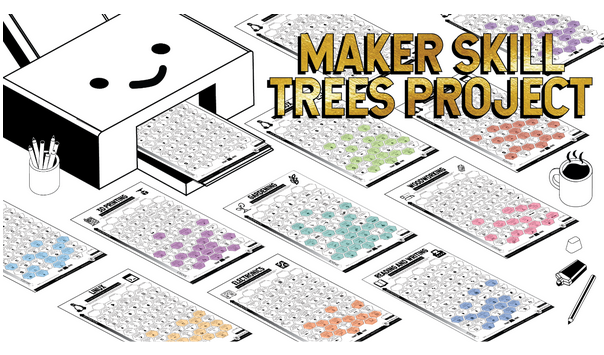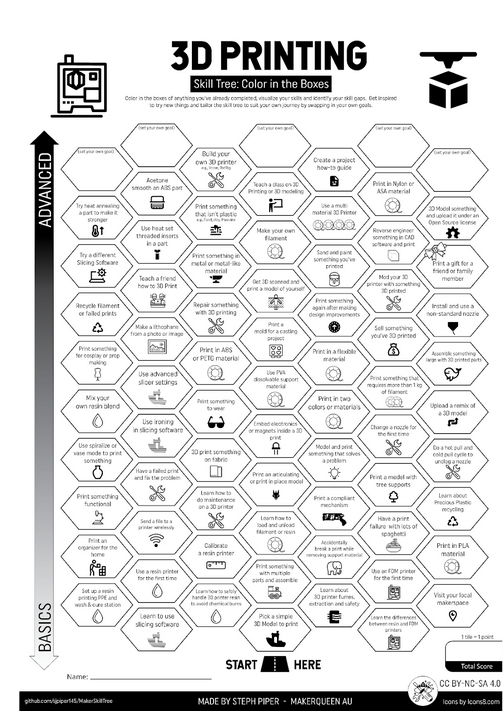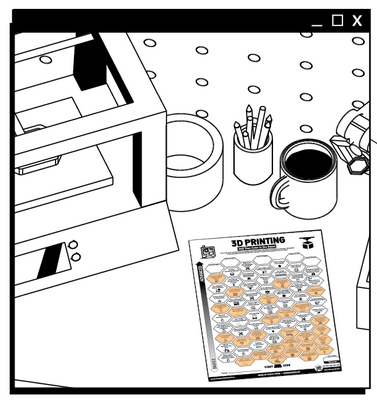Authentic Assessment
Using Skill Tree Templates to Gamify Learning
University of Southern Queensland
Steph Piper
Overview
Gamification can be a powerful tool for motivating learners, providing feedback and rewarding progress (Sailer, 2020). Skill Tree templates are based on this idea and explore the idea of using video game skill tree design to track real-life skills. When you play a video game, you can see your skill progress, see what’s next and know how to level up your skills to get to the next stage. What if you could do this with real-life skills? This simple paper template format includes a spectrum of hexagonal skill tiles, from basics at the base to advanced skills at the top. Get an idea of your skill progress, skill gaps and get inspired to try new things. Pick a skill you’re interested in and colour in anything you’ve already completed on the printable template.
Skill Trees Project is a repository of these skill tree templates across a huge range 60 + skill areas, from electronics to gardening and woodworking to leadership. The Skill Trees project is licenced with the Creative Commons CC-BY-NC-SA licence, which allows the project to make resources available freely while allowing select commercial usage to keep the project sustainable.
This accessible and learning centred approach delivers a reflective experience where users can find their current skill levels and set goals for future progress. Skill trees bring together multiple concepts into a single template, incorporating gamification, goal setting, flexibility, self-grading rubrics, and portfolio building to create an off-screen experience for upskilling and self-reflection to reduce distractions. Often, as self-guided, informal learners without structured guidance, we often aren’t aware of our own skill gaps and may become stagnant in our skill sets. These skill trees aim to be a catalyst for improvement, where users can be motivated to try new things and pursue new skills.
Currently, the project has an active community of contributors who submit new skill areas, peer review current skills, and translate skill trees into other languages. The internationally published Skill Seeker book series has emerged from this project and includes maker skill trees, plus a dashboard to show skill levels and achievement badges to unlock.

Using this case study
This case study provides models of gamification in authentic assessment. Readers will:
- Understand the theory of skill tree templates and their role in open-access teaching.
- Learn about the Skill Trees project and how it has grown an active community of users.
- Learn more about the future of the Skill Trees Project and how to contribute.
Key stakeholders
The Skill Trees Project originated as an independent initiative by creative technologist Steph Piper. Templates are often used within her role as the Makerspace Coordinator at the University of Southern Queensland as part of orientation and workshop activities. The ‘How to use the Library’ and ‘Makerspace’ skill tree templates incentivise students to participate in non-compulsory learning, often with prizes. Since the repository was placed online, the Skill Trees Project has grown a community of 30-50 active visitors per day, and an active community of GitHub contributors who share completed skill areas and submit their own skill trees to grow the repository. Others have created code-based solutions for the project, including a skill trees generator app and various converters that can switch between ‘machine-readable’ and ‘human usable’ versions of skill trees. This has increased the usability and accessibility of the project.
Background
In educational settings, gamification can be used to improve engagement, motivation and educational outcomes (Sailer, 2020). Elements of video games that can enhance learning include badging, leaderboards, challenges, points and progress bars. Badging, points and progress bars provide learners with immediate feedback, rewarding progress and incentivising further growth. Gamified learning apps such as Duolingo use these elements, where users can view their progress and see what’s next.
Self-determination theory is a theory of motivation which emphasises the satisfaction of learners’ needs for competence, autonomy and social relatedness, and plays a part in gamification. Including personal choice and agency, a sense of relevance and shared goals make a more powerful impact on learning outcomes (Rigby & Ryan, 2011).
Skill Tree templates lean into these motivational factors, providing the user with feedback at their skill level after they use the template and colour in tiles they’ve already completed. Users may feel a sense of accomplishment for their progress so far, combining motivational badging feedback and a sense of relevance. Furthermore, after the skill tree is fully coloured in, there’s an opportunity for self-reflection and goal setting. Users may highlight tiles that are interesting goals to work towards and can interpret those goals in a way that is interesting and relevant to their current ability and journey. This provides choice and agency in skill progression, rather than a standardised learning approach that removes self-ownership and creativity.
This is also part of the constructivist approach to teaching, where the student is at the centre of their own learning, building on what they already know rather than repetition. Vygotsky’s seminal work “Zone of Proximal Development” describes three levels of capability: the inner zone, where a student can act independently; the next zone, where tasks can be completed with assistance; and the outer zone, which represents what the student cannot yet do (McLeod, 2024). Using Skill Tree templates, we can identify these different zones efficiently in a skill area, allowing more student-centred learning at their individualised skill level.
Furthermore, using the templates can act as a catalyst for growth, allowing users to identify skill gaps and find areas where they may be growing ‘stagnant’. It’s easy to grow comfortable with current tools and ways of working, without putting in the extra effort into learning new technologies and different ideas. Learners may not be aware of missing skills until prompted by structured tools like skill trees.
Design choices
The titles of the skill templates are designed to capture the essence of each skill and its relevance, while allowing flexibility for interpretation. Rather than ‘Make a clock’ under the woodworking skill area, it might be ‘add electronics to a project’, which can include a rich variety of things and allow the user to interpret the goal based on their own interests and available materials.
Tiles start with foundational skills at the base of the template. For example, in woodworking, ‘Learn how to use hand tools safely’ and in robotics, ‘Assemble a robot from a kit’ are the starter tiles. Progressing up the skill tree, tiles include safety considerations to learn about, and materials, tools and techniques. Types of projects are also included, for example ‘Make something for the home’, ‘Make something artistic’ and ‘Make something practical’. One or two failure tiles are included, like ‘Have a print failure’ in the 3D printing skill tree, and ‘Get something wrong and try again’. Failure tiles reinforce the idea of failure as part of normal progress. Plus, social and community building tiles include gifting something you’ve made to a friend, teaching a friend a skill, visiting a local community space, releasing a tutorial or guide and teaching a class on the skill area. The social dimension ensures peer-to-peer support and knowledge sharing across learners.

Not every tile in a skill tree needs to be completed, and a skill tree can be used as a base for goal setting, where you might swap tiles that don’t suit personal goals for added flexibility. The aim is for users to interpret the template as a ‘custom goal setting tool’, where tiles can be swapped as needed to suit the individual’s ability, as well as financial and time constraints.
Video game skill trees are most often built from connected nodes, restricting progress along skill tree branches and locking progress. Original draft template ideas attempted to include this feature, but this proved difficult to implement and less relevant for real-life skills. Often, self-directed learning is guided by the time, motivation, equipment and teachers available. Learning pathways in this space are not all followed in the same order with the same path, and learners may progress non-linearly and complete skills out of order. This is why a spectrum of difficulty was chosen in the template design rather than the classic ‘connected node’ video game skill tree design.
This project is also intentionally paper-based, allowing users to complete skill trees in an off-screen, distraction-free environment if desired. It is most effective when combined with reflective journaling practice for a meditative, self-reflective experience. Future use of the skill trees project will likely include online versions, which may enhance the user experience by linking resources and providing a skill dashboard for users.
Learnings and recommendations
Skill trees have multiple applications for self-directed learning, including portfolio building, workshops and teaching and skills mapping, explored below.
Portfolio building
If you need to show a skill set without certifications, a portfolio of skill trees can help show a potential employer the breadth of your skill set in a comprehensive but easily interpreted way. This supports recognition of informal or community-based learning.
Workshops and teaching
Using skill trees can serve as a starting point for teaching a skills workshop. Find out the skill levels of workshop participants and identify higher-level participants who may be able to assist others. Point out the tiles that will be covered in the session and invite participants back for more advanced sessions that build on the skills covered previously.
Furthermore, if you’re a teacher with a STEM club, home-schooled students or looking for holiday activities, using skill tree templates can help keep activities engaging and varied while letting the students choose what they’d like to cover next.
In a makerspace environment, skill trees make it easy for new and experienced members to find appropriate entry points and go at their own pace while creating their desired projects.
Skills mapping
Teams in the workplace may use skill trees to create skill maps of their employees, showing expertise and skill gaps that can be mapped on spreadsheets. This is helpful to identify internal expertise and plan professional development to fill skill gaps. Furthermore, they are useful for training new staff members on desired skill areas.

Champion statements
“This is amazing, what a brilliant idea and implementation. I especially like that there is flexibility in the way to reach each goal and it is up to the person to determine that they have gained a skill or not.”
-Myrthos@techhub.social
“This is an amazing idea. I can see so many opportunities for use in training, personal growth, and education. It shows the goal and a path. It’s rare to find something that opens up so many new possibilities.”
-docquinn@mas.to
“Wow, this is a great idea. Finding inspiration for something you are already doing a little or a lot. But it is also a fun way to peek into fields/disciplines you are not familiar with to get a sense of what they are about through their achievement milestones.”
-Docdoo@hachyderm.io
“I’m a teacher-turned instructional designer, and it just resonates. I would like one for teaching, design, language, cooking, and basically every single thing that has a skillset.”
-Hawkmoon@mastodon.social
Key outcomes
The Skill Trees Project continues to expand, now adopting a more structured submission process that uses tables to highlight where new contributions are needed and where past contributions require peer review. Translators are also invited to contribute when a skill tree is fully peer-reviewed and complete, allowing more accessibility for diverse users. Community incentives are available to encourage engagement (e.g. badges, merchandise), and the main GitHub repository page receives 30-50 unique visitors on average per day. The project is licenced under CC-BY-NC-SA, and is free to use for teaching, schools and commercial workshops. However, users are not permitted to create books with the Skill Trees project, and software development usage is possible after sponsoring the project.
In practice
Educators and learners can explore the templates on the Skill Trees Repository Github Page: https://github.com/sjpiper145/MakerSkillTree/
- Pick a skill that you’re interested in.
- Colour in the boxes of anything you’ve already done.
- Highlight tiles you’d like to set as goals.
- Reflect on your current journey and plan for the future.
References
McLeod, S. (2025). Zone of proximal development. Simply Psychology. https://www.simplypsychology.org/Zone-of-Proximal-Development.html
Rigby, S., & Ryan, R. M. (2011). Glued to games: How video games draw us in and hold us spellbound. Praeger.
Sailer, M., & Homner, L. (2020). The gamification of learning: A meta-analysis. Educational Psychology Review, 32(1), 77–112. https://doi.org/10.1007/s10648-019-09498-w
Image descriptions
Figure 1: Maker skill trees project banner
Image showing the Skill Trees project banner with the title ‘Maker Skill Trees Project’ in gold. The banner includes a cartoon-style smiling paper printer. Several coloured Skill Tree templates are spread on a desk, alongside a mug, highlighters, and pencils.
Figure 2: Example skill tree for 3D printing
An example skill tree for 3D Printing. Tiles at the base, in the basics section, have things like ‘Pick a simple model to 3D print’ and ‘Learn how to use slicing software’ and move up to advanced tiles like ‘Teach a class on 3D Printing’ and ‘Build your own 3D printer’.
Figure 3: An illustration of the 3D printing skill tree
An illustration of the 3D printing Skill Tree, mostly coloured in, next to a 3D printer, a hot drink and pencils.
Acknowledgement of peer reviewers
The authors gratefully acknowledge the following people who kindly lent their time and expertise to provide peer review of this chapter:
- Bianka Malecka, Senior Lecturer (Education-Focused), University of Sydney
- Dr Ala Barhoum, Visiting Fellow, Australian National University, Centre for Learning and Teaching
How to cite and attribute this chapter
How to cite this chapter (referencing)
Piper, S. (2025). Using Skill Tree Templates to Gamify Learning. In Open Education Down UndOER: Australasian Case Studies. Council of Australian University Librarians. https://oercollective.caul.edu.au/openedaustralasia/chapter/using-skill-tree/
How to attribute this chapter (reusing or adapting)
If you plan on reproducing (copying) this chapter without changes, please use the following attribution statement:
Using Skill Tree Templates to Gamify Learning by Steph Piper is licensed under a Creative Commons Attribution 4.0 International licence.
If you plan on adapting this chapter, please use the following attribution statement:
*Title of your adaptation* is adapted from Using Skill Tree Templates to Gamify Learning by Steph Piper, used under a Creative Commons Attribution 4.0 International licence.


